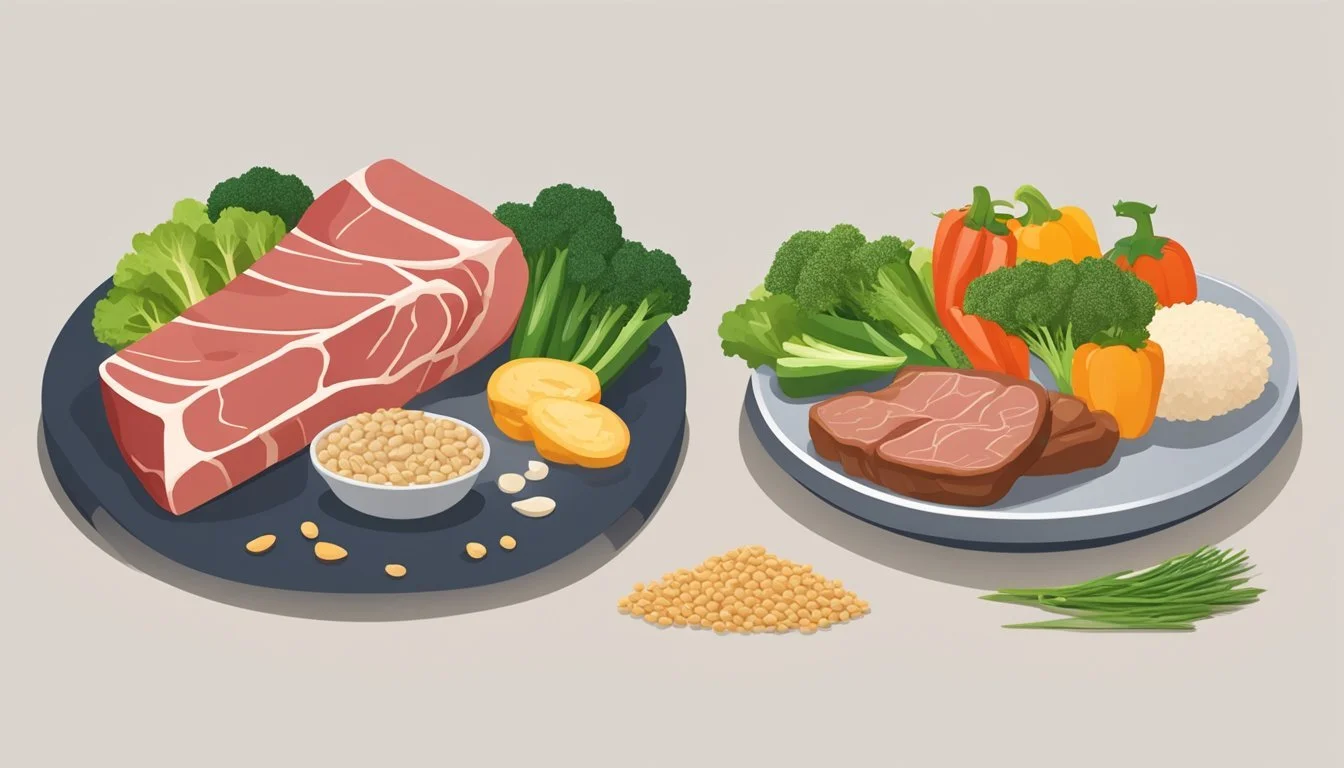Carnivore Diet vs. The Starch Solution
Evaluating Starchy Vegetables and Grains Impact
The Carnivore Diet and The Starch Solution represent two distinct approaches to eating, each with its own set of principles and claims about health benefits. The Carnivore Diet emphasizes a meat-based eating plan, deriving most nutritional intake from animal products while eliminating plant-based foods. Advocates suggest that this diet can lead to improved health outcomes by reducing inflammatory markers and cutting out carbohydrates.
On the other hand, The Starch Solution is a high-carbohydrate, low-fat diet that promotes the consumption of starch-rich foods such as potatoes, rice, and other whole grains as the primary energy source. This diet includes a mix of 70% starches, 20% vegetables, and 10% fruits, arguing for the benefits of plant-based eating in managing body weight and preventing chronic diseases. The diet eliminates most processed and prepackaged foods and restricts healthy fats, aiming to capitalize on the purported health advantages of whole, unrefined plant foods.
While these diets are positioned at opposite ends of the dietary spectrum, both share a commitment to eliminating processed foods and aim to improve health outcomes. The contrasting philosophies highlight the ongoing debate on the optimal dietary pattern for health and well-being, with each leveraging historical and scientific narratives to support its approach.
Understanding the Carnivore and Starch Solution Diets
The Carnivore and Starch Solution diets represent two very different approaches to eating, with unique guidelines and health claims. This section will explore their definitions, historical context, and the key figures behind these dietary systems.
Definitions and Core Principles
Core Principle: Exclusive consumption of animal products.
Dietary Composition: Mainly meat, fish, eggs, and certain dairy products.
Starch Solution:
Core Principle: A plant-based diet centered on starch-rich foods.
Dietary Composition: Approximately 70% starches from whole grains and legumes, 20% vegetables, and 10% fruits.
Historical Perspectives
The Carnivore Diet harkens back to the presumed eating patterns of Paleolithic ancestors who relied heavily on hunting. This diet, although lacking a singular historical advocate, has been gaining modern popularity through anecdotal success stories and online communities.
The Starch Solution, conversely, is a modern construct based on the idea that traditional populations have thrived on starch-based diets. It emphasizes the consumption of complex carbohydrates as a primary energy source.
Diet Advocates: Dr. McDougall and Carnivore Proponents
Dr. John McDougall:
A physician and author, Dr. McDougall champions the Starch Solution.
He argues for the health benefits of a low-fat, starch-centered diet.
Carnivore Diet Proponents:
The Carnivore Diet lacks a central figure but has numerous advocates within the low-carb and ketogenic communities.
They assert that a meat-focused diet can support health and eliminate the need for plant-based nutrition.
This section offers insight into the basic tenets put forth by advocates of both diets and highlights the stark contrast between their dietary frameworks.
Nutritional Composition and Sources
The Carnivore Diet and The Starch Solution represent two ends of the dietary spectrum in terms of their recommended food sources and nutritional makeup. Analyzing the composition and sources of nutrients within these diets reveals considerable differences in their approach to health.
Animal Products vs. Plant-Based Foods
Animal products, including meat, dairy, and eggs, serve as the foundation of the Carnivore Diet. They are primary sources of protein and saturated fats while being void of carbohydrates. Specific staples include beef, butter, and organ meats, which are rich in nutrients yet low in fiber. Conversely, The Starch Solution emphasizes plant-based foods like whole grains, legumes, and vegetables, which are high in starches, dietary fiber, and various micronutrients, but generally lower in protein and fat compared to animal products.
Role of Macronutrients: Proteins, Fats, and Carbohydrates
The macronutrient distribution in these diets is starkly contrasting:
Proteins are primarily sourced from animal foods like meat and fish in the Carnivore Diet, while The Starch Solution relies on legumes and some grains for protein.
Fats are significantly present in the Carnivore Diet, sourced from animal products, such as meat and butter. In The Starch Solution, fats are typically lower and primarily come from foods like avocados, nuts, and seeds, albeit in restricted amounts.
Carbohydrates are virtually absent in the Carnivore Diet but are the cornerstone of The Starch Solution, which focuses on starches from beans, whole grains, and starchy vegetables.
Vitamins and Minerals Profile
The micronutrient content varies greatly between the two diets. Here's a brief summary:
Animal products offer a range of vitamins like B12 and minerals such as iron and zinc. The Carnivore Diet's reliance on animal products ensures a dense intake of these nutrients.
The Starch Solution's plant-based composition provides an array of micronutrients from vegetables, fruits, and whole grains such as vitamin C, potassium, and magnesium. However, certain nutrients like vitamin B12 and omega-3 fatty acids are less abundant in plant foods and may require careful attention to meet dietary needs.
Both diets provide necessary nutrients through their distinct food sources, yet their approaches to achieving nutritional adequacy rely on fundamentally different philosophies regarding the roles of meat and plant-based foods.
Health Outcomes and Medical Considerations
In evaluating dietary choices like the Carnivore Diet and The Starch Solution, it is crucial to consider their impact on various health conditions and medical outcomes. Evidence and clinical studies have indicated differing effects of these diets on chronic diseases, weight management, and overall health.
Weight Management and Obesity
The Carnivore Diet is often associated with weight loss due to its low carbohydrate content, which can lead to a state of ketosis and increased satiety from high protein intake. Conversely, The Starch Solution emphasizes a high-starch, low-fat diet which proponents claim could contribute to weight loss through calorie density and increased fiber.
Heart Disease and Cholesterol Levels
The Carnivore Diet’s high saturated fat content from animal products raises concerns about elevated cholesterol levels and an increased risk of heart disease. On the other hand, The Starch Solution, rich in whole grains and starchy vegetables, has been connected with lower levels of bad cholesterol (LDL), potentially reducing the risk of atherosclerosis and hypertension.
Diabetes and Glycemic Control
Diabetes patients might experience improved glycemic control on the Carnivore Diet due to minimal sugar and carbohydrate intake. Yet, The Starch Solution, with its focus on low-glycemic index foods, suggests that it could help in controlling blood sugar levels and supporting long-term diabetes management.
Cancer Risks and Diet Correlation
A diet rich in animal protein, as seen in the Carnivore Diet, has faced scrutiny for potential correlations with increased cancer risks. In contrast, The Starch Solution's plant-based approach, emphasizing fruits and vegetables, aligns with research suggesting a possible protective effect against certain cancers.
Inflammation and Autoimmune Diseases
The Carnivore Diet claims to reduce inflammation and improve autoimmune conditions, citing the removal of potentially irritating plant compounds. The Starch Solution, while plant-centric, also purports anti-inflammatory benefits through its elimination of processed foods and emphasis on whole food sources.
Dietary Impact on Longevity and Chronic Diseases
The intricate balance of nutritional intake can profoundly affect longevity and the incidence of chronic diseases. This section examines the role of distinctive dietary patterns, particularly the Carnivore Diet and The Starch Solution, in shaping health outcomes.
Prevention Strategies
Carnivore Diet: Followers consume exclusively animal products, which may lead to a high intake of certain nutrients like protein but could also result in deficiencies in others, potentially affecting their risk for chronic diseases. For example, the absence of fiber-rich vegetables and grains could impact gut health and the management of diseases like type 2 diabetes and heart disease.
Nutrient Considerations:
High Protein: Supports muscle maintenance and growth.
Low Micronutrient Variety: May necessitate supplementation.
The Starch Solution: A dietary approach centered on starchy vegetables and grains, rich in fiber and essential micronutrients, which may lower the risk of developing chronic conditions such as cardiovascular disease and diabetes. It prioritizes sustainable, plant-based foods that have been associated with longevity.
Benefits of High Fiber:
Weight Management: May improve with better satiety.
Blood Sugar Control: Fiber helps manage glucose levels, potentially reducing disease risk.
Dietary Patterns for Optimal Health
Both diets offer contrasting paths towards optimal health, emphasizing different sources of macronutrients and micronutrients that can significantly affect disease risk factors and longevity.
Carnivore Diet Considerations:
Risk Mitigation: It is essential to monitor for potential risks associated with high saturated fat and cholesterol intake.
Chronic Disease Implications: It can be challenging to ensure heart health without the benefits of plant-based antioxidants and fiber.
The Starch Solution Advantages:
Diverse Nutrients: A richer array of vitamins and minerals is typically available from the consumption of whole grains and starchy vegetables.
Longevity Factors: Populations with diets high in complex carbohydrates from plant sources tend to exhibit enhanced longevity and lower rates of chronic diseases.
Each dietary pattern can influence the body's health in specific ways, and adhering strictly to either diet must be done with a full understanding of the potential impacts on longevity and the prevention of chronic diseases.
Comparative Analysis of Diet Sustainability
When comparing the sustainability of the Carnivore Diet and The Starch Solution, it's crucial to evaluate their environmental impact and economic viability—key metrics for assessing dietary sustainability.
Environmental Impact
Carnivore Diet:
Land use: High, due to the focus on animal products.
Greenhouse gas emissions: High, livestock production is a significant source.
Biodiversity: Can be negatively affected by the demand for pasture and feed crops.
Starch Solution:
Land use: Lower, relies on crops like potatoes, beans, and grains.
Greenhouse gas emissions: Lower, plant-based diets generally produce fewer emissions.
Biodiversity: Potentially positive, if crop rotation and polyculture are practiced.
Economic Viability
Carnivore Diet:
Cost efficiency: Lower, meat products often cost more than plant-based options.
Access: Challenging in regions without affordable meat.
Starch Solution:
Cost efficiency: Higher, starchy vegetables and grains are often less expensive.
Access: Widely accessible, as staples are globally available.
Both diets advocate unprocessed, natural foods, yet their sustainability profiles differ sharply. The Carnivore Diet's reliance on animal products presents challenges for long-term sustainability, while The Starch Solution's plant centrality appears more economically and environmentally tenable.
Diet Implementation and Daily Life
Adopting a new diet requires thoughtful planning and consideration, particularly when it comes to daily meals and navigating various social scenarios. The Carnivore Diet and The Starch Solution present distinct approaches to nutrition, and each demands specific strategies for seamless integration into everyday life.
Developing a Meal Plan
The Carnivore Diet: Meal plans focus exclusively on animal products, with staples such as:
Breakfast: Scrambled eggs, bacon
Lunch: Chicken breasts with cheese
Dinner: Grilled steak, organ meat
The Starch Solution: This starch-based diet emphasizes plant sources, with a typical daily meal plan comprising:
Breakfast: Oatmeal or brown rice pudding
Lunch: A hearty lentil soup or a quinoa salad
Dinner: Baked sweet potatoes, mixed vegetable stir-fry (What Wine Pairs Perfectly With Vegetable Stir-Fry?)
Both diets require adherence to their core principles, with the Carnivore Diet eliminating all plant-based foods and The Starch Solution focusing on high-carbohydrate, low-fat vegan foods.
Managing Cravings and Social Scenarios
The Carnivore Diet: Participants may manage cravings by allowing for variety within the animal product spectrum. In social settings, they might opt for meat-centered dishes or buffet items, such as:
Social meals: Barbecues, steakhouse gatherings
The Starch Solution: To navigate cravings, individuals can explore various starch-based recipes, incorporating different spices and herbs. Socially, they must seek out or request vegan options, focusing on:
Social meals: Vegan-friendly restaurants, potlucks with plant-based dishes
Dietary Modifications and Variations
The Carnivore Diet: Allows for some degrees of personalization, such as:
Modifications: Including minimal dairy, adopting high-fat vs. low-fat variations
Example Variation: Some might incorporate high-fat dairy products or use certain spices for flavoring.
The Starch Solution: Supports a variety of starches and plant-based foods within the following parameters:
Modifications: Adding small amounts of nuts or avocados for fat content (as tolerated)
Example Variation: Including whole grains like barley or non-starchy vegetables to diversify meals.
Implementing either diet demands a concerted effort, with plans tailored to individual preferences within the framework of the respective diet's guidelines.
Common Myths and Misconceptions
The debate between the Carnivore Diet and The Starch Solution often brings a plethora of myths and misconceptions to the forefront. Both diets, representing extreme ends of the dietary spectrum, have attracted controversy, and dissecting the popular beliefs from the scientific evidence is crucial.
Assessing Popular Beliefs
Myth: The Carnivore Diet leads to nutritional deficiencies because it excludes all plant-based foods. This is a common belief that aligns with concerns over a lack of fiber and certain vitamins. However, proponents of the diet argue that animal products can provide all essential nutrients that humans require.
Myth: The Starch Solution lacks protein and healthy fats, leading to poor health outcomes. Contrary to this belief, the diet emphasizes that appropriate concentrations of protein and healthy fats can be sourced from starchy vegetables, grains, and legumes, without resorting to animal products.
Myth: Eating meat exclusively is inherently unhealthy and leads to increased levels of 'bad' cholesterol. While it's widely accepted that certain cuts of meat are high in saturated fats, which can impact cholesterol levels, the link to heart disease is frequently oversimplified, and some studies suggest a more complex relationship between saturated fats and cardiovascular health.
Diet Approach: Misconception vs. Reality
Carnivore
Misconception: High cost and less affordability
Reality: Meat can be comparably priced to processed foods, considering long-term health costs.
Starch Solution
Misconception: Over-reliance on 'unhealthy' carbohydrates
Reality: Differentiates between simple sugars and complex carbohydrates, emphasizing the latter for sustained energy.
Clarifying Scientific Evidence
Fact: Not all fats are created equal. The Starch Solution distinguishes between saturated fats typically found in animal products and healthier fats present in nuts, seeds, and certain oils. However, the diet recommends minimizing fat intake, including the use of vegetable oils.
Fact: Processed foods can be high in both sugar and harmful fats. While the Carnivore Diet eliminates the intake of processed foods inherently by forbidding plant-based foods, The Starch Solution also advocates for the reduction of processed food consumption, recognizing the negative health impact of added sugars and processed fats.
In terms of scientific evidence, it's important to recognize that dietary requirements can vary based on individual health conditions, activity levels, and metabolic differences. No one-size-fits-all diet exists, and nutrition science often evolves with new research findings. Both the Carnivore Diet and The Starch Solution promote whole, unprocessed foods while condemning the overconsumption of sugar and processed foods, a stance that most nutrition experts agree on.
The Role of Healthcare Professionals
Healthcare professionals play a pivotal role in guiding individuals through dietary choices, specifically when comparing dietary approaches such as the Carnivore Diet and The Starch Solution. Their expertise aids in achieving optimal health while mitigating potential risks associated with extreme diets.
Guidance from Registered Dietitians and Nutritionists
Registered dietitians and nutritionists are the primary sources of individualized diet planning and management. When navigating the complexities of diets like the Carnivore Diet and The Starch Solution, they provide:
Personalized Assessments: Careful evaluation of an individual's nutritional needs based on their health status, lifestyle, and goals.
Evidence-based Recommendations: Tailored advice that aligns with the latest research findings to promote optimal health.
Interpreting Expert Opinions
Healthcare professionals must decipher and convey expert opinions and research to their patients in an understandable manner. They serve as a bridge between scientific evidence and practical application. Responsibilities include:
Critical Analysis: Reviewing scientific literature on diets such as the Carnivore Diet and The Starch Solution to ensure recommendations are based on sound evidence.
Risk-Benefit Evaluation: Assessing potential benefits against risks for specific individuals, such as nutrient deficiencies or chronic disease management.
Conclusion
The Carnivore Diet and The Starch Solution present contrasting approaches to health and nutrition. The Carnivore Diet emphasizes meat and animal products, excluding starchy vegetables and grains, while The Starch Solution prioritizes plant-based starches, alongside a moderate quantity of fruits and vegetables.
Carnivore Diet:
Focus: Animal products
Health Benefits: Potentially beneficial for those seeking a low-carb lifestyle; anecdotal reports include improved digestion and energy levels.
Nutrient Density: High in protein and certain vitamins, yet lacks certain micronutrients found in plants.
Weight Management: May aid in satiety due to high protein content; however, long-term effects on health markers require further research.
The Starch Solution:
Focus: Plant-based starches, vegetables, fruits
Health Benefits: May offer cardiovascular and glycemic control benefits due to high fiber and complex carbohydrates.
Nutrient Density: Rich in micronutrients, fiber, and phytochemicals; restricts processed foods and added fats.
Weight Management: Can support weight loss efforts, as it is typically lower in calories and high in satiating fiber.
Individual needs and responses to these diets will vary. Both diets should be approached with careful consideration of one's health status, nutritional needs, and lifestyle. Consultation with healthcare and nutrition professionals is recommended for personalized advice tailored to individual health goals and nutritional requirements.






